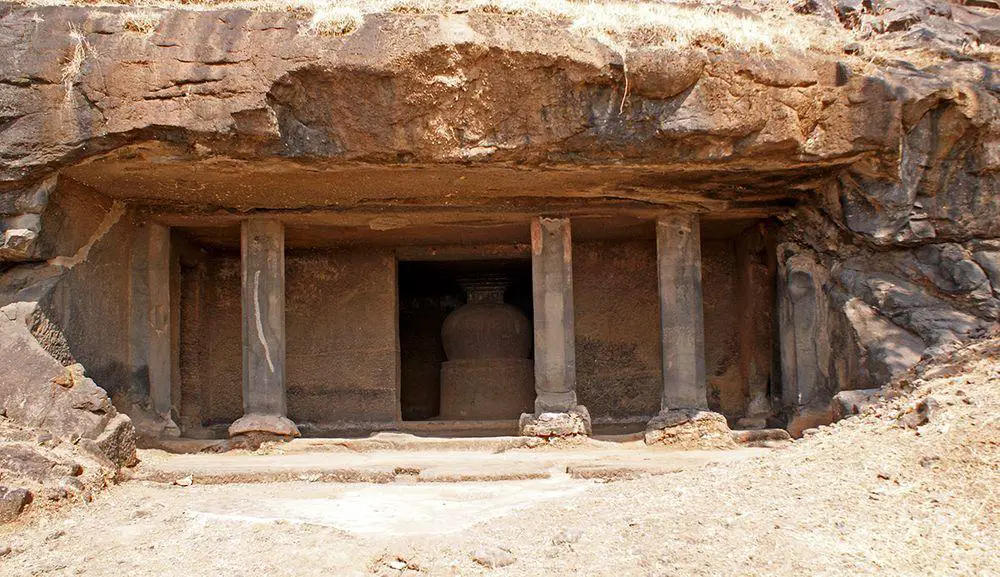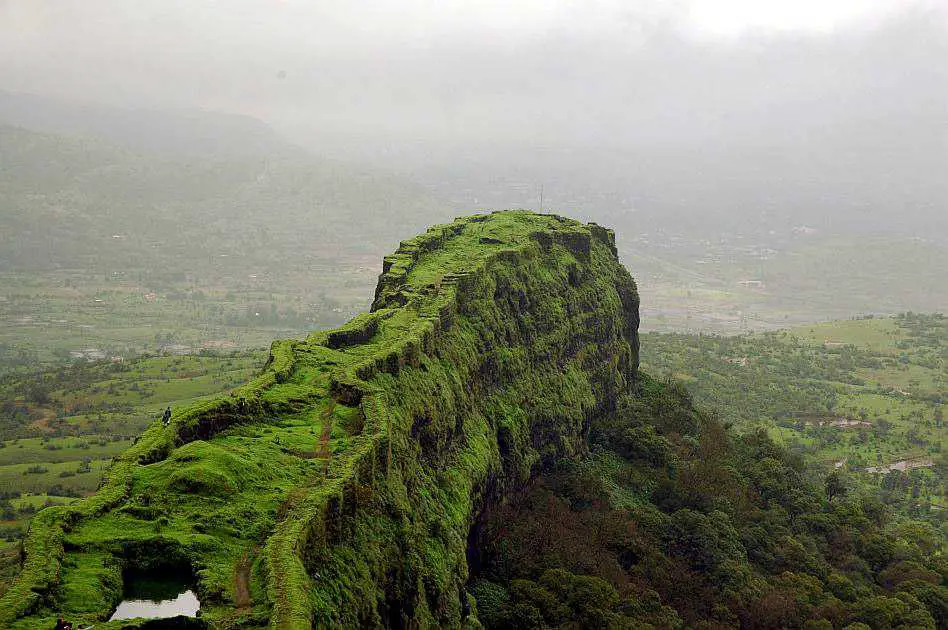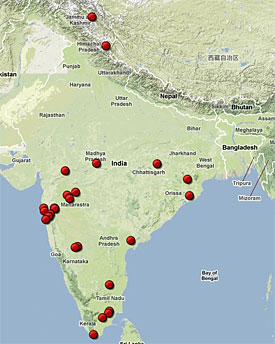World 🢖 Asia 🢖 India 🢖 Maharashtra
Buddhist shrines 🢔 Religious architecture 🢔 Archaeological wonders 🢔 Categories of wonders
Wonder
Kuda Caves

 In short
In short
There is a group of ancient rock-cut Buddhist caves in central Maharashtra, near the sea, at Janjira creek. These are Kuda Caves – 26 caves made for Buddhist mendicants some 1700 – 2100 years ago.
 40.3%
40.3%
GPS coordinates
Location, address
Age
Religion
Map of the site
If you see this after your page is loaded completely, leafletJS files are missing.
 In detail
In detail
Buddhist temples near ancient port
Often the oldest Buddhist rock-cut caves were made near port cities and on ancient trade routes. Seems that Kuda Caves were not an exception to this. Most likely here was located the ancient port of Mandagora mentioned by Ptolemy, ancient Greco-Roman geographer.
Caves were cut for Buddhist mendicants in Hinayana tradition, in the 1st century BC – 3rd century AD. Later, in the 6th – 7th century AD there were made additions in Mahayana tradition – including numerous sculptures of Buddha.
26 caves
Kuda Caves are 26 rock-cut caves and 11 rock-cut cisterns. Some count more caves here, for example 28 – but these other caves are just small chambers.
Caves are located some 45 – 60 m above the sea level, they are cut in the side of some 75 m high hill.
All caves are located in compact group, outer caves are not further than 200 m away. Entrances open to the south-west, there opens beautiful view on fine landscape – estuary with steep hills around it.
Researchers have numbered the caves – from Cave I to Cave XXVI.
Part of caves – caves I-XV are located somewhat lower but caves XVI-XXVI are located some 12 m higher.
Sculptures, inscriptions and paintings
For thousands of years these caves have experienced the impact of storms and rain. Natural forces have erased sculptures, inscriptions and drawings in the front part of caves. Less exposed inscriptions and artwork though have been preserved.
Interior of Kuda caves for the most part is plain and not adorned, caves are quite similar.
There is an exception though – Cave VI has lavish interior with many reliefs.
Walls of caves were plastered with earth and rice-shaff. Several caves contain traces of paintings.
As it is common in ancient rock-cut architecture, the design of caves strives to imitate wooden architecture.
Many caves contain inscriptions, Cave VI contains even six inscriptions. Five of these inscriptions (in Cave VI) belong to the 5th – 6th century AD. All other inscriptions have writing characteristic for the 1st century BC. Nearly all inscriptions mention the names of donors to the monastery and the donated gift – cave, cistern.
Five caves are chaityas – temples – with dagobas – shrines – inside. Other caves are leni – created for dwelling. Lenis for most part consist of verandah with a door and window in the rear wall. Behind the rear wall there is cell or chamber with cells with rock-cut benches where monks slept.
Doorframes contain a groove – once here were placed wooden doors.
Description of caves
- Cave I consists of verandah with two pillars and two pilasters. Walls in antechamber contain traces of plaster. Cell above the door contains inscription which tells that the cave has been donated by some Sivabhuti.
- Cave II has small forecourt. Walls also contain traces of plaster.
- Cave III contains traces of inscription, mentioning the person who donated this cave.
- Cave IV contains front court with benches and steps leading to verandah. Verandah has two pillars and two ornamented pilasters, cave is large.
- Cave V also is large, contains traces of plaster. Cistern in front. Verandah has one pillar. Cave contains three inscriptions. One mentions the person who donated cistern and ends with swastika. Second inscription has five lines and is nearly unreadable – it hints at some donors. Third inscription is inside the verandah and consists of six lines and mentions that cave has been donated by female ascetic Padumanika.
- Cave VI is chaitya and the most interesting cave in this monument. Forecourt adorned with sculpture of front part of standing elephant – initially there were two but one is lost. In the front of cave there is small sculpture of Buddha, seated on a throne, upheld by naga. Two vidyadharas hold a crown over Buddhas head. Above this sculptural group there is arch supported by sculptures of alligators and with two flying figures above. Interior of the cave is adorned also with sculptures of Buddha, Avalokitesvara, women, lion with dwarves, elephant, bull, tiger. Main hall contains sculptures added here in the 5th – 6th century, sculptures have remnants of paint on them. Whole interior of the cave – columns, ceiling, walls – contain traces of plaster and painting. Inside the cave there are several inscriptions left by donors. Left end of verandah contains long inscription with beautiful calligraphy, in seven lines. This inscription also is left by donor.
- Cave VII has a plain forecourt with two cisterns in front. Verandah has two columns and two pilasters. Walls have remnants of plaster. Left end wall contains inscription in four lines which tells that cave has been donated by physicist Somadeva. One cistern also contains inscription left by donor.
- Cave VIII is an oblong chamber with benches for monks.
- Cave IX is chaitya. It has verandah with two columns and one pilaster, it contains chamber with dagoba. Walls contain traces of plaster. Inscription left by donor.
- Cave X has small forecourt, damaged front part. Oblong hall inside with a cell to the right. Inscription left by donor – gardener.
- Cave XI has open verandah, damaged front part. On the right end wall of verandah inscription left by donor.
- Cave XII is in bad condition, with verandah nearly lost. Contains inscription telling that this is dwelling-cave of Goyamma, daughter of minister. Inscription starts with an etching of lion.
- Cave XIII has an open verandah, this is dwelling. Contains inscription left by donor.
- Cave XIV is similar to previous cave. Inscription of donor. In front of cave cistern with inscription.
- Cave XV is chaitya. It located somewhat further away – some 50 m from previous cave. Verandah has four columns. Contains shrine with dagoba. Traces of plaster on the walls and roof, traces of paintings on columns. Well preserved inscription in one long line, made by donor.
- With this cave ends the first “line” of Kuda Caves and next cave belongs to the next group.
- Cave XVI has two cisterns in front. Front part of cave has a bench along the facade. Cave itself is an oblong chamber and cell at rear wall. Cave contains inscription left by donor – nun. Another inscription is left on the cistern – this cistern has been donated by a gardener.
- Cave XVII is similar to the previous one, contains traces of plaster. Inscription by donor – trader and house-keeper.
- Cave XVIII contains traces of plaster on walls and inscription left by donor – some merchant.
- Cave XIX has plain forecourt, verandah and cell. Remnants of plaster on walls.
- Cave XX is a bit harder to access. Front part is nearly lost.
- Cave XXI was planned as chaitya but not finished. It has plain forecourt and two roughly cut pillars leading into verandah. Chamber is unfinished, there is rock massif intended as dagoba. Cistern in front with inscription left by donor – merchant.
- Cave XXII has a court with bench in front. Cave consists of chamber, also with a bench. Cistern in front of cave.
- Cave XXIII contains inscription left by donor.
- Cave XXIV contains inscription left by trader – donor. Front part of verandah is broken.
- Cave XXV also has lost front part. Part of verandah and chamber behind it.
- Cave XXVI has a common wall with cave XXV, it is partly broken. Small chamber behind verandah.
References
- Kuda Caves, Maharashtra State Gazetteers, acccessed on May 29, 2010.
- Sunil Gupta, Iron Age / Early Historic Port-sites on the Indian Coastlands (gallery), acessed on May 29, 2010.
Kuda Caves are included in the following article:
 Linked articles
Linked articles

Buddhist shrines
Buddhism is one of the world religions and at the same time is a spiritual philosophy with diverse traditions, beliefs, and practices. There exists a rich tradition of architecture expressed in Buddhist temples and monasteries.

Wonders of Maharashtra
Maharashtra is a truly splendid state. It has everything – enormous metropolises and countless waterfalls in mountains, urban decay, and architectural splendor, remnants of millennia-old Harappan towns, and modern, very expensive architecture.

Wonders of India
India is the seventh-largest country in the world by area, and, naturally, such a large area contains a huge amount of exciting attractions…
Wondermondo considers that India is the second richest center of architectural heritage in the world after Europe and maybe no single country in the world can match it in this respect.
 Recommended books
Recommended books
India Unveiled: Spirit, Tradition, People
This is the one book you need to understand the spirit of India. Internationally acclaimed as the best book of its type on India, this sixth expanded, revised edition of the multi-award winning book India Unveiled: Spirit, Tradition, People by Robert Arnett truly reveals the diversity and sacredness of the oldest continuously living civilization on earth.
India: A Sacred Geography
A spiritual history of the world’s most religiously complex and diverse society, from one of Harvard’s most respected scholars.



